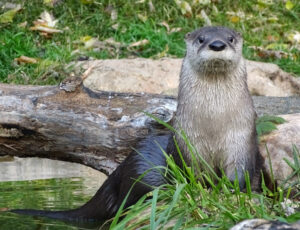
Edward Mardigian Sr. River Otter Habitat
The 2,500-square-foot Edward Mardigian Sr. River Otter Habitat incorporates indoor and outdoor living environments. A 9,000-gallon aquatic area includes an outdoor oasis, complete with a sandy beach and a flowing stream. The retreat features a waterfall and waterslide. Natural light pours into the new rustic design of the building, with exposed raw wood logs comprising the walls, evoking a handcrafted log cabin. Floor-to-ceiling acrylic windows provide visitors with dramatic views of the animals exploring their habitat, and underwater viewing remains for even the tiniest of guests to get nose-to-nose with these charismatic creatures.
The North American river otter (Lontra canadensis) can weigh 20-30 pounds, and its slender, cylindrical body can reach 2-3 feet in length, not including the tail, which can be 1-1.5 feet long. The aquatic mammal sports short, dense, waterproof fur and profuse whiskers. The playful river otter is swift on land as well as in the water, though its loping trot can look somewhat ungainly compared to its graceful slide through the water.
Once abundant in U.S. and Canadian rivers, lakes and coastal areas, river otter populations have suffered significant declines as a result of fur trapping, water pollution, habitat destruction, pesticides and other threats. Today, they can be found in parts of Canada, the Northwest, the upper Great Lakes area, New England and Atlantic and Gulf Coast states.






